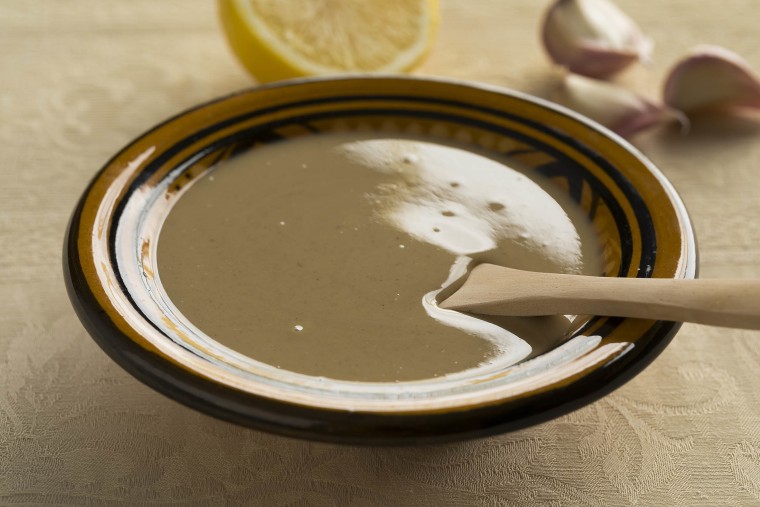Tahini can be a bit mysterious in the international foods aisle, but you’ve likely had it if you’ve eaten hummus — it’s a key ingredient in the popular dip. It also comes with a healthy profile that dietitians like.
“Nutritionally, it’s packed with heart-healthy monounsaturated fats,” Elisabetta Politi, a registered dietitian at the Duke Lifestyle and Weight Management Center in Durham, North Carolina, tells TODAY.com.
“It’s a good fat, so it’s like an avocado,” adds Lisa Young, Ph.D., a registered dietitian and adjunct professor of nutrition at New York University. “If you’re having olive oil or avocado or tahini, it’s going to be somewhat similar.”
What is tahini?
It’s a butter made from toasted ground sesame seeds and a bit of oil. Tahini is vegan and a popular ingredient in Middle Eastern and Mediterranean cuisine.
Tahini can be used in a salad dressing, as the base of a sauce or spread on sandwiches.
What does tahini taste like?
Tahini provides a mellow, nutty flavor that’s also slightly bitter in a good way, says Joy Bauer, nutrition and healthy lifestyle expert for TODAY.
It’s often described as creamy, smooth and rich. Epicurious calls it “peanut butter’s sophisticated cousin.”
Tahini nutrition
One tablespoon of tahini contains the following, according to the U.S. Department of Agriculture:
- 90 calories
- 2.5 grams of protein
- 8 grams of fat
- 3 grams of carbohydrates
- 1.4 grams of fiber
Tahini has no sugar or cholesterol. It’s full of nutrients, including calcium, magnesium, phosphorus, copper, potassium, manganese, folate and selenium.
Tahini health benefits
It’s made with seeds, which are always nutrient dense because they contain all the starting materials that develop into the whole plant, says Madelyn Fernstrom, Ph.D., health and nutrition editor for NBC News.
Sesame, in particular, has been called the “seed of immortality” because of its rich nutritional value and use as a traditional medicinal plant, researchers note.
Tahini has anti-inflammatory properties, Young says. The calcium and magnesium in it are important for healthy blood pressure, and the monounsaturated fat it contains is a heart-healthy fat, she adds.
Sesame seeds are a good dietary source of phytosterols, compounds in plants that can reduce total and LDL cholesterol, according to the University of California, Davis department of nutrition.
“It’s not going to elevate your LDL, your bad cholesterol, but it’s going to keep your good cholesterol elevated,” Young notes.
Meanwhile, the phosphorus and manganese in tahini both play a role in the prevention of bone loss, Politi says.
Tahini also contains lignans, plant compounds and powerful antioxidants that may play a role in the reduction of some cancers, she adds.
Is tahini high in estrogen?
Lignans are phytoestrogens, which means they may have weak estrogenic effects, according to the Centers for Disease Control and Prevention. Because of this, the relationship between phytoestrogens and health is complex and more research is needed, Politi says.
Lignans positively influence female hormones, explains registered dietitian Natalie Rizzo, nutrition editor for TODAY.
One review of studies found the reported benefits of phytoestrogens include a lower risk of menopausal symptoms, cardiovascular disease and cancer of the breast, prostate, bowel cancer and uterus.
But phytoestrogens are also considered endocrine disruptors, suggesting they could cause infertility and increased risks of cancer in estrogen‐sensitive organs — though these adverse effects were mainly observed in test tube and animal studies, the review authors wrote.
“Currently, there is no evidence that tahini, consumed in moderation, increases the risk of any kind of cancer or any other disease,” Politi says.
“The Mediterranean diet, which frequently includes tahini, has been shown to reduce risk of cancer.”
Is tahini healthier than peanut butter?
They’re both healthy, dietitians say.
Tahini is lower in carbohydrates and sugars than peanut butter is making it a better choice for people who follow low-carb diets, Politi notes.
Both foods are predominantly fat, though peanut butter has a little more protein, Young adds.
“People always want to say, ‘This is better than this,’ but it really depends on how it fits in with your whole entire diet,” she says.
How much tahini should I eat daily?
Between 1 to 2 tablespoons of tahini per day, both dietitians advise.
About 80% of the calories in tahini comes from fat, Politi notes. It’s heart-healthy, but a little bit goes a long way, Young adds.
How to use tahini
Politi recommends mixing it with roasted eggplants and garlic for a flavorful dip known as baba ganoush.
Tahini can be added to soup for increased creaminess, whisked into a vinaigrette or salad dressing or used as a spread on sandwiches, she adds.
Young prefers using a tahini sauce — a diluted version of the tahini paste sold in jars. It can be a dip for veggies, mixed in with canned tuna instead of mayonnaise or drizzled on grilled chicken in a pita, she says.

